
Join Amazon Prime - Watch Thousands of Movies & TV Shows Anytime - Start Free Trial Now
Armies of the Wars in India
1740 -1816
by Paul D. Stevenson

Miniature Wargames No. 3
Introduction
Part of the appeal in wargaming colonial wars is to oppose small but well trained Europeans against hordes of natives, but also, because actual numbers involved were generally small, colonial battles are easily adaptable as wargames.
When one mentions colonial warfare one immediately thinks of the late Victorian British soldier in his pith helmet fending off large masses of screaming Zulus, Afghans or Dervishes. The 18th century takes a back seat to 19th century colonial wargaming and this is in the main due to a dearth of material when compared with the well documented and photographed 19th century.
Inherent in the earlier wars in India there is much scope for wargamers who play Seven Years War and Napoleonic wargames with British and French forces They can expand their period geographically by enlisting native sepoy units into their armies. A later period colonial wargamer will already have the native figures in his collection (tribal dress altered little over the years) and need only add a few European units in period uniforms to expand backwards chronologically.
The period saw many small scale wars, which offer a good diversity of troop types and weapon types. Europeans supplemented by their native auxiliaries may face off with one another or against feudal native armies and mercenaries. Intrigue and politicking were the order of the day and some interesting scenarios could be devised around limited campaigns in miniature.
In this series of articles I propose to look at the main elements of the various armies that fought in India during the period 1740 to 1816.
The Moghul Army
The Moghul Empire was founded by a Mongol tribe from Central Asia. Headed by their leader, Babur, the 12,000 Mongols defeated an Indian army of 100,000 at Panipat to the north of Delhi in 1525.
The Mongols were swift and hardy horsemen but several generations after Babur the Moghul armies went to war as massive slow moving columns. Princes would indulge themselves in great wealth and their personal possessions often required hundreds of camels for transportation. Great artillery trains of huge siege guns drawn by scores of plodding bullocks always accompanied the army, further slowing down it's movements.
illustrated below, from left to right:
Indian Matchlock man, Moghul Cavalryman & Arab Mercenary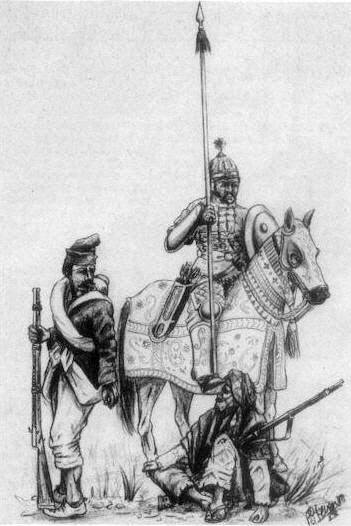
Moghul Cavalry
Cavalry composed the bulk of an army and they enjoyed considerable prestige as warriors. They were very good horsemen, possessing considerable expertise with their personal weapons but fighting largely as individuals. Moghul cavalry men were armed with a variety of weapons. Usually each warrior carried a composite bow and a very sharp curved sword called a 'tulwar'. Other weapons additionally carried were a light bamboo lance, an embossed metal shield and various knives, one of which was peculiar to India, this was a punching dagger known as a 'katar'.
The cavalry dressed in bright colours with pastel shades being the most common. Most cavalry wore some kind of armour. This was usually a mail shirt covered with embroidered cloth pieces or quilted and padded. Metal plates covering thighs, shins and the lower arm were also worn. Wealthier cavalrymen clad their horses with quilted or mail barding often covered in richly decorated cloth.
Cavalry tactics were straight forward and consisted of a massed charge by mail clad warriors over flat terrain. Horses were trained to rear up on their hind quarters when in combat with elephants.
The cavalry were recruited in two ways. A rich nobleman (silladar) who showed allegiance to a particular prince would equip and mount men (bargirs) on his own horses at personal expense. The other method of recruitment was for the prince to pay an officer (mansabdar) to recruit men. Like the colonels in the British army of the time pay was often drawn for vacant places in the unit. One such extreme incident concerned an officer who could muster only 70 of the 1,700 men he drew pay for.
Mansabdars held various rank according to the number of men commanded. The lowest ranking mansabdar commanded 20 men the highest commanded 7,000. High ranking mansabdars were of three classes. They were of the first class if the whole command was of horsemen, of the second if more than half the command was of horsemen and of the third class if less than half the command was horsemen.
As regards pay, this was nearly always in arrears, not only because cash may have been in short supply but also as a check to desertion. Desertion nevertheless was so rife that absconders were allowed three months grace to rejoin the army.
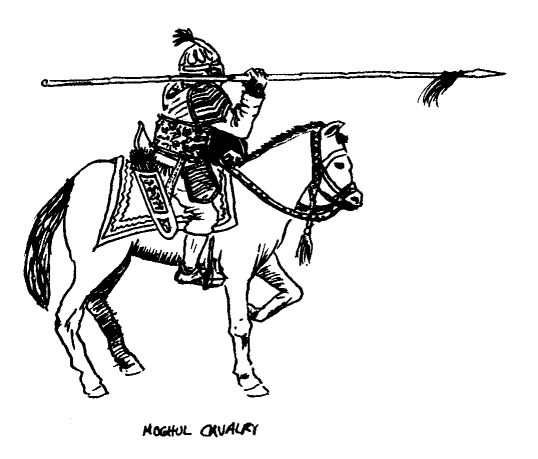
Moghul Artillery
The huge guns favoured by the Moghuls were looked upon almost as gods. The gunners were considered the most reliable troops in the army as they were paid directly by the state. The enormity of their guns is apparent when considering that the largest siege guns used by the British were 24 pounders and that 48 pounders were considered average size in Moghul armies. One Indian gun called 'Malik-i-Maidon' ('Master of the Field') fired a roundshot weighing 2,646 pounds. Generally speaking most of the artillery transported to the battlefield were not larger than the 9.5 inch 'Zam-Zama' ('Thunderer'). Because of their size and the relative inefficiency of the Indian gunners and despite their longer range the Moghul guns were far out-classed by the lighter and more manoeuvrable guns of their European foes which delivered a more accurate and higher rate of fire. In action Moghul guns were chained together as an obstacle to charging cavalry.
Some of the lighter guns were mounted on mobile platforms, bullock drawn and pushed from the rear by elephant. Very light 1 pdr. and ½ pdr. guns were mounted on camels (Zambereks or Zambuks), or on elephants (Gingals or Jingals).
Rockets were very popular with Moghul armies. The rockets were simply explosive devices fixed to a bamboo shaft, often with a blade attached to its head. The rockets were ignited and thrown by hand, travelling a wildly erratic course for up to 1,000 yards. Because of this and their small bursting charge, rockets were only effective against large bodies of troops and to scare animals. Rocketeers usually carried their rocket supply in carts or on camels and when not in use the shafts were ornamented with small pennons.
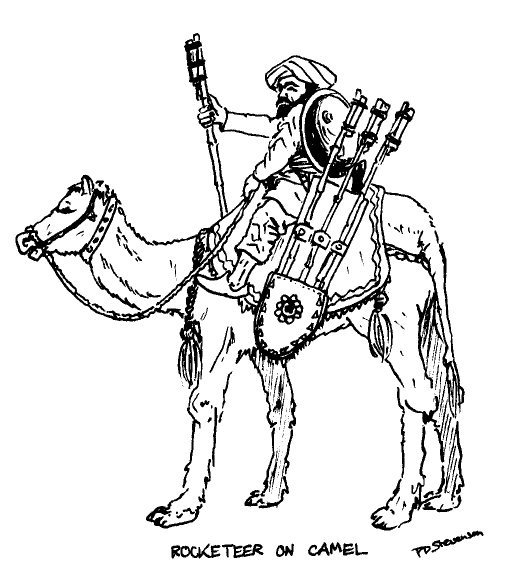
Elephants
The Indian Prince always rode on an elephant into battle and often duplicates were employed to avoid detection by the enemy of his whereabouts. The prince was carried on a richly decorated 'howdah' with an attached canopy or parasol. The elephant was usually armoured with metal strips or mail with plate arranged above the elephant's head. The elephant was often draped in finely embroidered material and decorated with painted designs usually of a floral pattern.
As well as for artillery draught and jingals, elephants were used for labour tasks utilising their trunks for carrying and lifting purposes. They were also used on the battlefield to charge and break up enemy formations. The fighting men crewing the howdah were armed with matchlocks and bows and a long bamboo pike for sticking the unfortunates below.
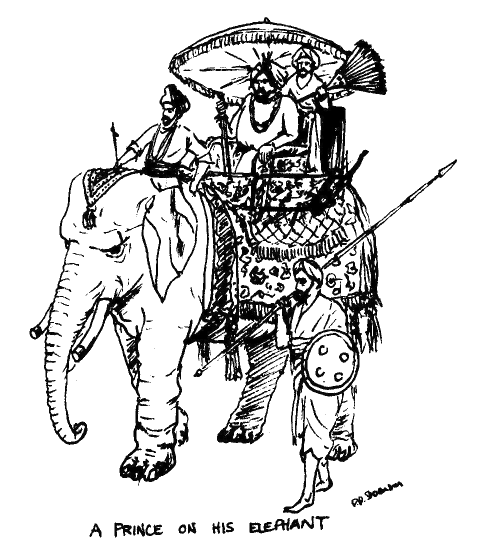
Moghul Foot
Foot soldiers were considered the lowest of the low - only the matchlock men had any degree of status. The matchlock was used throughout the period. It was slower to load than the flintlock musket and required yards of slow match, wrapped around the shooter's body with which to ignite the powder and so discharge the weapon. Matchlockmen were usually organised into units and wore similar garb or distinguishing features such as turbans and waist sashes in a common colour. If also seems likely judging from contemporary paintings that each unit would carry a small triangular flag or horse hair decorated standards.
Religious fanatics called 'Ghazis' were sometimes present in Moghul armies. These most ferocious men would work themselves into a frenzy, stoned out of their minds on hashish and charge the nearest enemy in a headlong rush heedless of losses. Their one wish in life was to die fighting for the Moslem faith. The Ghazi's favourite weapon was a sharp slashing sword but other weapons such as matchlocks, pistols and knives were also carried. Peculiar to the Ghazis were sharpened steel quoits which were hurled at the enemy from close quarters - when not in use these quoits were worn around the turban. Some Ghazis also fought on horseback.
Foreign mercenaries were often employed by Indian princes because of the low quality of the foot soldiers. Arabs were particularly sought after and they were paid the highest wages. Sita Ram who was a British sepoy in the early 19th century had this to say of the Arab soldiers;
"They did not run away but died at their posts like men. They were expert marksmen . . . These men live like jackals and fight like Ghazis."
As further testament to the quality of these mercenaries at the Battle of Araguuam 1,000 of their number charged the British line unsupported, most of them were killed. Arabs were armed with long curved swords (saifs) and the jezail - a long barrelled matchlock, though later flintlock musket.
Other mercenaries came from northern parts of India, Afghanistan and even Persia. The northern races were traditionally warlike peoples stronger and taller than southern races. The Rajputs were an outstanding warrior race with a high code of honour. Like the Arabs these mercenaries were primarily armed with the jezail and were employed as horsemen as well as foot soldiers.
The rest of the Moghul foot consisted of levies armed only with bamboo spears and bows. They were considered fit only for manual labour and were kept in the rear when the army formed for battle. Invariably they ran away as soon as an opportunity presented itself.
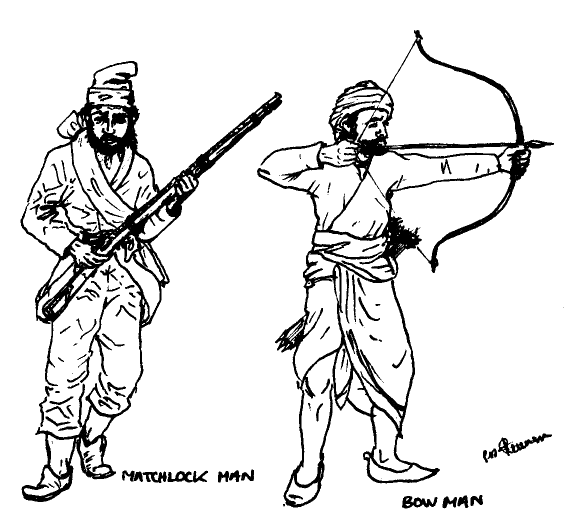
Suggested Wargames Army 1100-2000 points, (based on W.R.G. Rules 1685-1845)
Prince on elephant @ 110 points. Vizier on elephant @ 30 points.
Sub commander for elephants, mounted on elephant @ 30 points. (Only if elephants used).
Sub commander on horse @ 20 points; 1 per 2 to 8 units fielded.
Silhidar Cavalry. 12 to 20 irregular fanatic cavalry with bow @ 9 points; up to 2 units.
Mansabdari Cavalry. 20 to 25 irregular warrior cavalry with bow @ 8 points; 2 to 6 units.
Mercenary Cavalry. 8 to 12 irregular soldier cavalry with jezail @ 10 points; up to 2 units.
Matchlock men. 20 irregular warrior charging infantry with matchlock @ 3 points; 2 to 4 units.
Arab Mercenaries. 12 to 20 irregular fanatic skirmishing infantry with jezail @ 5 points; up to 1 unit.
Afghan Mercenaries. 12 to 20 irregular soldier skirmishing infantry with jezail @ 4 points; up to 1 unit.
Ghazis. 20 irregular fanatic charging infantry armed for hand-to-hand combat only @ 4 points; up to 1 unit.
Levies. 20 irregular levy charging infantry armed for hand-to-hand combat only @ 1 point; 2 to 4 units.
Levies. 20 irregular levy skirmishing infantry with bow @ 2 points; 1 to 3 units.
Rocketeers. 10 irregular warrior rocketeers @ 20 points (additionally mounted on camels @ 2 points each); up to 1 unit.
Zambereks. Very light gun, 1 raw regular gunner mounted on camel @ 16 points; up to 5
War Elephant. 3 fighting warriors with bow or matchlock mounted on elephant @ 19 points; up to 5.
Gingal Elephant. Very light gun, 2 warrior crew mounted on elephant @ 30 points; up to 5.
Artillery. 1 siege gun @ 50 points, 5 raw regular gunners @ 4 points each and 10 pairs of bullocks including limber and driver @ 11 points = 81 points; 2 to 8.
See also Armies of the Wars in India: The British Army by Paul D. Stevenson
Armies of the Wars in India: Part IV The Mysoreans by Paul D. Stevenson
Information about the Mysore Wars of Haidar Ali and Tipu Sultan, illustrations, maps of southern India and portraits.